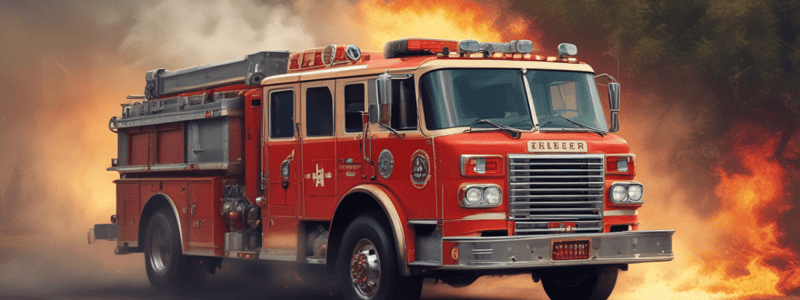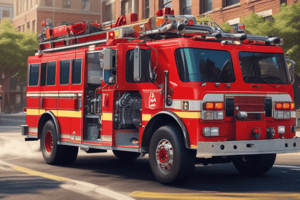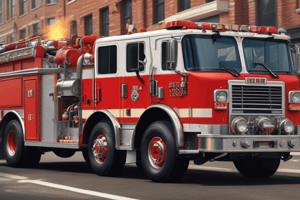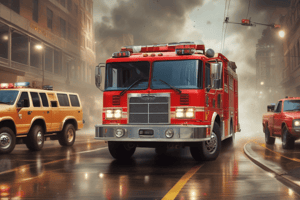Podcast
Questions and Answers
What is the minimum number of 45mm hose lines that personnel should deploy for attacking any vehicle fire?
What is the minimum number of 45mm hose lines that personnel should deploy for attacking any vehicle fire?
- Four
- One
- Two (correct)
- Three
What is the primary purpose of the backup line in a vehicle fire?
What is the primary purpose of the backup line in a vehicle fire?
- To create a smoke-free zone
- To provide additional water supply
- To cool down the surrounding area
- To act as a second attack line if needed (correct)
What should personnel do before attacking a vehicle fire?
What should personnel do before attacking a vehicle fire?
- Observe the interior of the vehicle for occupants (correct)
- Check the surrounding area for hazardous materials
- Call for additional resources
- Check the vehicle's fuel type
When should foam be used to combat a vehicle fire?
When should foam be used to combat a vehicle fire?
What type of foam percentage should be used for vehicle fires with fuel involvement?
What type of foam percentage should be used for vehicle fires with fuel involvement?
Why should Apparatus Drivers avoid closely passing a vehicle that is fully involved in fire?
Why should Apparatus Drivers avoid closely passing a vehicle that is fully involved in fire?
What is the minimum distance that Apparatus should be positioned from a vehicle fire?
What is the minimum distance that Apparatus should be positioned from a vehicle fire?
When responding to a vehicle fire involving liquefied natural gas, where should the pumper be positioned?
When responding to a vehicle fire involving liquefied natural gas, where should the pumper be positioned?
Why should a Pumper apparatus be positioned on higher ground and upwind?
Why should a Pumper apparatus be positioned on higher ground and upwind?
What is a potential hazard that personnel should be aware of when responding to a vehicle fire in a sloped driveway?
What is a potential hazard that personnel should be aware of when responding to a vehicle fire in a sloped driveway?
What personal protective equipment (PPE) should TFS personnel wear when exposed to smoke or contaminants at an incident scene?
What personal protective equipment (PPE) should TFS personnel wear when exposed to smoke or contaminants at an incident scene?
How should crews make their work area safe during icy conditions?
How should crews make their work area safe during icy conditions?
Why might water supply be an issue on highways?
Why might water supply be an issue on highways?
What options might aid in extinguishing a fire on a highway?
What options might aid in extinguishing a fire on a highway?
Flashcards are hidden until you start studying
Study Notes
Firefighting Tactics for Vehicle Fires
- Personnel should wear all PPE, including SCBA, for all vehicle fires.
- A minimum of two 45mm hose lines should be deployed and charged: one for an attack line and one for a backup line.
- The attack line should be set at the proper pressure and flow rate, and the backup line should be set similarly.
- Personnel should observe the interior of the vehicle for occupants before attacking the fire.
- The wheels of the vehicle involved in the fire should be chocked to prevent horizontal movement.
- A constant water supply should be ensured to the hose lines.
Attack Strategy
- Approach the vehicle at an angle of approximately 45 degrees.
- Extinguish any ground fire around or under the vehicle.
- Attack the remaining fire in the vehicle.
Foam Usage
- The Incident Commander may request foam to combat the fire.
- Class A foam percentages should be used for vehicle fires with no fuel involvement.
- Class B foam percentages should be used for vehicle fires with fuel involvement or vehicles with fuel spills.
Apparatus Deployment
- A second apparatus with an onboard tank and fire pump should be dispatched for vehicle fires on a 400 series highway, the Don Valley Parkway, or the Gardiner Expressway.
- A blocker apparatus should also be dispatched for a total of three apparatus.
- The Incident Commander can request any type of apparatus that will assist with extinguishing the vehicle fire.
Safety Considerations
- Apparatus Drivers should avoid closely passing a vehicle that is fully involved in fire while arriving at the scene.
- Apparatus should be positioned at least 30 metres from any vehicle fire.
- Pumper apparatus should be positioned on higher ground and upwind, where possible, unless the vehicle is fueled with liquefied natural gas (LNG), then it should be positioned on lower ground and upwind.
- For vehicle fires in sloped driveways, personnel should be aware of the potential hazard created by fuel spillage caused by tank rupture.
Additional Safety Measures
- All TFS personnel at the incident scene exposed to smoke or contaminants should wear all personal protective equipment (PPE) including SCBA.
- During icy conditions, crews should make safe their work area by using onboard salt and/or by having Communications call for a City salt truck via 311.
- Water supply may be an issue on highways due to hydrant access being some distance from the scene and sound barriers.
- The Incident Commander should consider their water supply options early, if they believe the fire will not be extinguished quickly.
Alternative Water Supply Options
- Water tanker
- Relay pump operations
- Foam operations
Studying That Suits You
Use AI to generate personalized quizzes and flashcards to suit your learning preferences.




